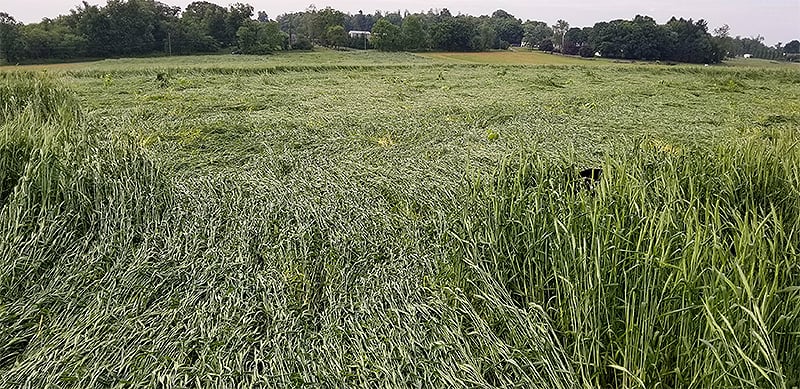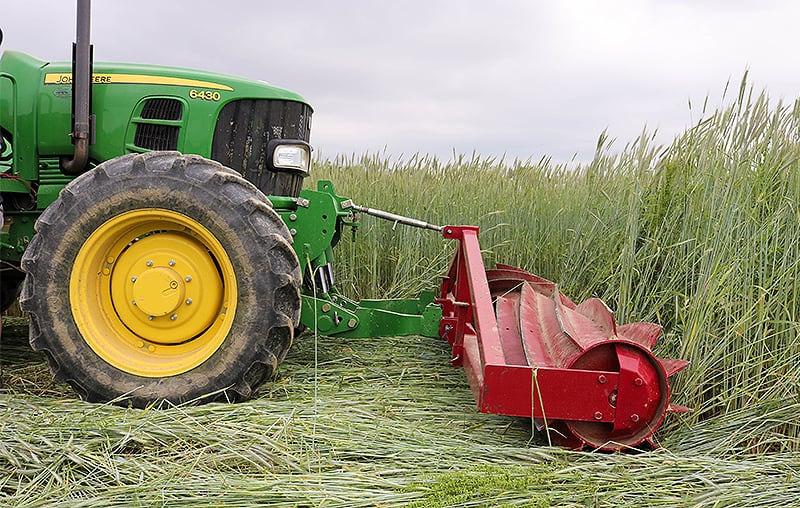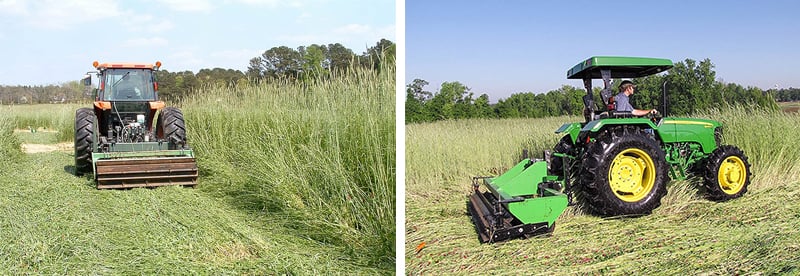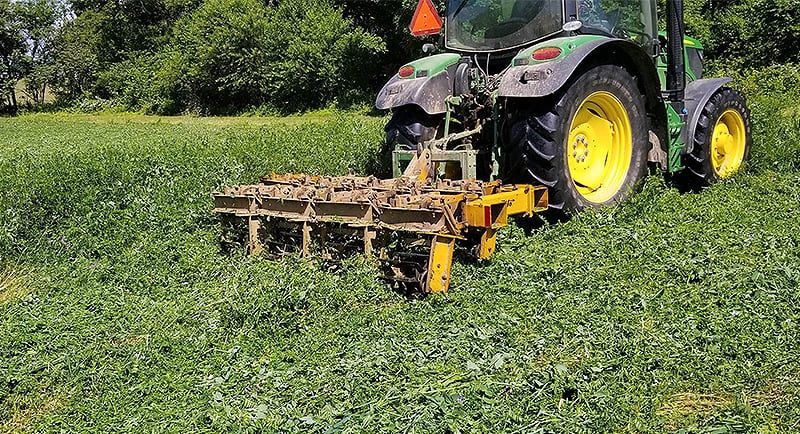When it comes to terminating cover crops, many growers rely on herbicides to get the job done.
But for growers looking to reduce or even eliminate their herbicide use, a roller-crimper provides an alternative solution.
Typically made of one or multiple drums with blunt blades, roller-crimpers work by pushing the cover crop down and crimping the plants along the way, which not only injures and kills the covers but keeps it on the ground, creating a thick mat of residue that will protect the soil and prevent weeds from germinating, says Erin Silva, an associate professor at the University of Wisconsin-Madison.
“We’re not cutting the plants, but damaging the stem to damage the vascular and limit the flow of water and sugars through the plant. That facilitates the termination of the cover crop,” says Silva, who also leads the university’s research on roller-crimping cover crops for use in organic no-tilled soybeans.
While roller-crimpers are simple to use, ensuring an effective cover crop kill with them is a little more complicated. Understanding the roller-crimper’s limits, using them at the right time, selecting the right cover crop species and seeding those covers at the appropriate rates are all key to making a successful termination possible.
3 TIPS
- Roller crimping impairs the stem to damage the vascular and limit the flow of water and sugars through the plant, which facilitates the termination of the cover crop
- Understanding the roller-crimper’s limits, using them at the right time, selecting the right cover crop species and seeding those covers at the appropriate rates are all key to making a successful termination possible
- Groff recommends growers who have contours in their field avoid using roller-crimpers that have sections wider than 10 fee
Understand Limitations
When Holtwood, Pa., no-tiller Steve Groff talks to farmers about using this practice, he warns them that it’s not a perfect system.
“When conditions are right, rolling cover crops and not using herbicides can work about one out of five times,” says Groff, , who’s been rolling and crimping covers since 1995. “One out of five times it’ll be a disaster, and three out of five it’ll be in the middle. That’s the realistic expectation.”
One of the reasons roller-crimping may not work is if the machine is unable to roll the entire cover crop. This is more likely to happen with larger roller-crimpers on undulating terrain, he says, as they can’t reach the cover crop where there are small dips in the field. For this reason, Groff recommends growers who have contours in their field avoid using roller-crimpers that have sections wider than 10 feet.

AVOID LODGING. No-tiller Steve Groff’s biggest challenge with roller-crimping is cover crop lodg-ing, where the stems lie in different directions, making planting more difficult. One solution is to roller-crimp the cover crop before it blows down, even if it’s too early for termination. Growers can then later finish termination by applying herbicides or roller-crimping the cover again.
Another possible limitation is whether the roller-crimper can be more aggressive through added weight or down pressure. How aggressive the roller-crimper needs to be is something growers will learn as they use the tool, Groff says.
However, it’s important that the machine isn’t so aggressive that it cuts the cover crop. If that happens it may regrow and the new growth could be more difficult to control.
“We don’t want the blades or angles too sharp,” he says. “We want them to be dull so they crimp. Most roller-crimpers are built with a somewhat blunt edge.”
If You Till, Consider Putting Your Roller Crimper in Front

For growers who are using roller-crimpers not attached to their planter, they have the choice of using them either in front of the tractor or behind. Cover crop coach Steve Groff says for those who are using tillage, they may want to put the roller crimper in front.
He explains that Rodale Institute does this because they discovered when they placed the roller behind it wasn’t able to effectively terminate the cover crop that was in the tractor tracks.
“They had planted their cover crop in tilled ground, so in the spring when they went in and rolled it, their tractor tracks made an indentation in the soil enough that it didn’t really crimp the cover crop and it came up in the tracks,” Groff says.
For those who are in a good conservation tillage system, tractor tracks shouldn’t be a problem, so they can choose whether to run it in front or behind. One benefit of running the roller-crimper in front is that growers can have their planter or drill behind, saving them an additional pass.
But without the ability to make the machine more aggressive, a grower may need to make multiple passes through the field to terminate the cover if they want to avoid using herbicides. Fortunately, if multiple passes are necessary, roller-crimping is a fairly fast task — Groff typically runs his machine around 9-10 mph.
Timing Termination
The biggest key to getting the roller-crimper to consistently terminate the cover crop is using it at the appropriate time.
For growers who don’t plan on using herbicides, this means waiting until the cover crop has reached the flowering stage, Silva says. For cereal rye and other grains, that’s anthesis — when anthers are hanging off the cereal grain heads and it’s shedding yellow pollen.
At that stage, it should lie flat on the ground after roller-crimping, she says. If it springs back up and continues growing, then the crop was rolled too early.
Avoid Clogged Up Radiators
For growers who plan on using just the roller-crimper to terminate their cover crops, Steve Groff warns they’ll have to deal with pollen, which can clog up radiators.
The Holtwood, Pa., cover crop veteran offers a couple solutions for farmers on dealing with this challenge. One is to install a reversible fan, which he admits is a pricey solution. Another is to roller-crimp early in the morning when there’s heavy dew, as that will help keep the pollen down. And third, growers could switch out cereal rye for triticale, as it doesn’t pollinate as heavily.
This is why Silva recommends erring on the later side of anthesis. “We want to see anthesis occurring throughout the rye head as well as throughout the field,” she says. “We don’t want to push it early, because the earlier we push it the more regrowth and bounce back we’re going to have.”
With broadleaves and legumes, they need to reach full bloom or early pod set to be terminated with the roller-crimper.
This is one reason why a planter-attached roller-crimper may not be the best option for farmers who would like to terminate their cover crops with just the roller-crimper, because planting may be earlier than when rolling needs to occur.
“One thought is you roll when it’s time to roll and you plant when it’s time to plant,” Groff says. “Those two timings may not be the same time. Sometimes you’ll need to come back and do it a second time.”
“We don’t want to push roller-crimping early, because the earlier we push it, the more regrowth and bounce back we’re going to have...” — Erin Silva
In fact, Groff advises organic farmers to plan on rolling twice, since they can’t rely on herbicides to aid in termination. But if a farmer plans on using herbicides in conjunction with roller-crimping, then timing of the roller-crimper doesn’t matter as much.
Groff says growers can either spray before or after roller-crimping, noting that he prefers to spray before because he feels he gets better coverage, but he’s also tried spraying after roller-crimping and it also tends to work fairly well.
Because cover crop termination has to occur later with roller-crimping, growers may need to plant cash crops into the cover crop before rolling or select a shorter-season cover crop species so it will reach maturity earlier, Silva says.
With soybeans, it’s possible to plant them into cereal rye at the boot stage and then roll the rye at anthesis, which is around the V2-V3 stage for soybeans. Silva says this allows soybeans to be planted 2-3 weeks earlier, rather than waiting until after the rye has been rolled and crimped.
As long as the soybeans aren’t too early in maturity — before V1 — then the roller-crimper doesn’t significantly damage the crop at that stage.
Selecting the Right Species
Due to the nature of the roller-crimper and the importance of its timing, some cover crops are better suited for this system than others.
Cereal rye is the most popular species because it grows rapidly and matures early. Silva recommends the Aroostook variety for organic farmers and those looking to avoid herbicides, because it reaches the flowering stage about 10 days earlier than other varieties.

DIFFERENT STYLES. There are a variety of shapes, sizes and styles of roller-crimpers available on the market, and Steve Groff says they can all get the job done. “If you have a roller-crimper that was designed to roll cover crops, they’re similar enough to say there’s not one that’s better than an-other,” he says. Photo credit: Photos by Ted Kornecki, USDA Agricultural Research Service
Groff adds that he seems to get better control of cereal rye when it’s mixed with hairy vetch, likely because the vetch helps keep the rye down. And because hairy vetch is succulent and tender, it’s also easily terminated by the roller-crimper.
Another mix Groff prefers is triticale with hairy vetch because they tend to mature very close together. When he uses them ahead of his no-till pumpkins, which are planted around the end of May or beginning of June, the roller-crimper will do most of the terminating, because both species will have reached full maturity.
Triticale is another species Silva recommends because it can achieve adequate biomass for weed control, and improved varieties are more winter hardy and less likely to lodge due to thicker stems. However, it doesn’t have the degree of allelopathic weed suppression provided by rye.
“We’re not cutting, but we’re damaging the stem to limit the flow of water through the plant, which facilitates termination of the cover crop…” — Erin Silva
Wheat and barley are also good options because they mature early, Groff says, and winter peas are easy to terminate.
Although not very common, rolling summer cover crops such as sunnhemp, cowpeas or buckwheat has been done with success. While crimson clover doesn’t terminate as easily as hairy vetch, Groff says that if it’s in full bloom the roller-crimper can do a decent job on it.
As for species to avoid, annual ryegrass is at the top of the list because it doesn’t have stems, so it can’t be effectively crimped, Groff notes. If growers want to use annual ryegrass on fields they will roll, he adamantly advises making an herbicide application several days before rolling.
Sorghum sudangrass should also be avoided if growers aren’t using herbicides, he says, as it will typically grow back.
Perennial grasses also can’t be used, Silva says, because they don’t reach full maturity like an annual grass does, so the roller-crimper won’t kill them.
Finally, oats are a species to consider avoiding as they can be difficult to roll. Groff says if growers don’t want to use herbicides the oat plants need to be well into the soft dough stage to be successfully terminated with a roller-crimper.
Consider Seeding Rates
Growers also need to be mindful of the rate they seed their cover crops. Organic farmers will need to seed at higher rates to achieve adequate biomass for weed control without chemical herbicides. Silva recommends they start at 3 bushels per acre with cereal rye. Groff says conventional farmers should begin with a lower rate on cover crops with high carbon-to-nitrogen ratios.
The reason for the lower rates is to lower the risk of lodging, which Groff says is the No. 1 challenge with roller-crimping. Lodging is usually the result of a wind or storm event or, Silva says, excessive soil fertility. Lodging will cause the cover crop stems to lie across the ground in every which way, making it difficult for a planter to cut through the cover and achieve good seed-to-soil contact. Hairpinning may also occur.
Build Your Own Roller-Crimper
For growers who are interested in building their own roller-crimper, Rodale Institute has free plans available on their website to replicate the chevron-style roller-crimper they use in their organic no-till operation: https://mk0rodaleinstitydwux.kinstacdn.com/wp-content/uploads/ROdale-Instutute-Roller-Crimper-Plans.pdf
One bushel of cereal rye is a good place to start, he says — unless growers are planting late, then increasing it to 2 bushels is fine. If growers plan on applying manure in the fall, go even lighter since it will make the rye even thicker.
While a thick seeding rate with high-carbon species can lead to lodging, the ratio of legumes in the field can affect it too, Groff says. He gives the example of hairy vetch, saying that it has “absolutely no standability,” and can climb up species like rye or triticale and pull them down.
One solution Groff has found to preventing lodging is to roller-crimp the cover crop before lodging occurs. One year, he roller-crimped his crimson clover when it was around 30-40% flowered about 3 weeks before planting, because heavy rain was expected the next day and he knew the cover would lodge. By roller-crimping it early, the clover continued to grow in the direction of his rows, making it easier to plant into.
When it’s time to terminate the cover crop, growers can either roller-crimp again or use herbicides.
Start Small, Learn All You Can
Groff reminds farmers that with roller-crimping, there will be good years and bad years. Which is why he advises farmers to start small and talk to others in their region to see what their experience with the practice has been.
“Don’t do the whole farm,” he says. “Don’t expect this practice to always work as good as you hear about. Start small, learn how this works, and learn what the limitations are.”
Silva agrees that roller-crimping isn’t a guaranteed success and growers should stay flexible and have a backup plan in case it fails.
“Don’t get too locked into a mindset of ‘you’re going to roller-crimp and terminate mechanically no matter what,’” she says. “You really do need to be adaptive with respect to this management system.”






Post a comment
Report Abusive Comment